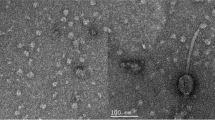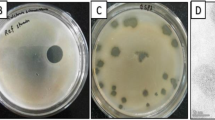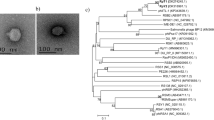Abstract
Bacterial spot is a highly damaging tomato disease caused by members of several species of the genus Xanthomonas. Bacteriophages have been studied for their potential use in the biological control of bacterial diseases. In the current study, bacteriophages were obtained from soil and tomato leaves in commercial fields in Brazil with the aim of obtaining biological control agents against bacterial spot. Phage isolation was carried out by co-cultivation with isolates of Xanthomonas euvesicatoria pv. perforans, which was prevalent in the collection areas. In a host range evaluation, none of the phage isolates was able to induce a lytic cycle in all of the bacterial isolates tested. In in vivo tests, treatment of susceptible bacterial isolates with the corresponding phage prior to application to tomato plants led to a reduction in the severity of the resulting disease. The level of disease control provided by phage application was equal to or greater than that achieved using copper hydroxide. Electron microscopy analysis showed that all of the phages had similar morphology, with head and tail structures similar to those of viruses belonging to the class Caudoviricetes. The presence of short, non-contractile tubular tails strongly suggested that these phages belong to the family Autographiviridae. This was confirmed by phylogenetic analysis, which further revealed that they all belong to the genus Pradovirus. The phages described here are closely related to each other and potentially belong to a new species within the genus. These phages will be evaluated in future studies against other tomato xanthomonad strains to assess their potential as biological control agents.
Similar content being viewed by others
References
Adhikari P, Adhikari TB, Louws FJ, Panthee DR (2020) Advances and challenges in bacterial spot resistance breeding in tomato (Solanum lycopersicum L). Int J Mol Sci 21:1734. https://doi.org/10.3390/ijms21051734
Adriaenssens E, Brister JR (2017) How to name and classify your phage: an informal guide. Viruses 9(4):70. https://doi.org/10.3390/v9040070
Adriaenssens EM, Sullivan MB, Knezevic P, van Zyl LJ, Sarkar BL, Dutilh BE, Alfenas-Zerbini P, Łobocka M, Tong Y, Brister JR, Moreno Switt AI, Klumpp J, Aziz RK, Barylski J, Uchiyama J, Edwards RA, Kropinski AM, Petty NK, Clokie MRJ, Kushkina AI, Morozova VV, Duffy S, Gillis A, Rumnieks J, Kurtböke İ, Chanishvili N, Goodridge L, Wittmann J, Lavigne R, Jang HB, Prangishvili D, Enault F, Turner D, Poranen MM, Oksanen HM, Krupovic M (2020) Taxonomy of prokaryotic viruses: 2018–2019 update from the ICTV Bacterial and Archaeal Viruses Subcommittee. Arch Virol 165:1253–1260. https://doi.org/10.1007/s00705-020-04577-8
Ahern SJ, Das M, Bhowmick TS, Young R, Gonzalez CF (2014) Characterization of novel virulent broad-host-range phages of Xylella fastidiosa and Xanthomonas. J Bacteriol 196:459–471. https://doi.org/10.1128/JB.01080-13
Araújo ER, Costa JR, Ferreira MA, Quezado-Duval AM (2012) Simultaneous detection and identification of the Xanthomonas species complex associated with tomato bacterial spot using species-specific primers and multiplex PCR. J Appl Microbiol 113:1479–1490. https://doi.org/10.1111/j.1365-2672.2012.05431.x
Araújo ER, Costa JR, Ferreira MASV, Quezado-Duval AM (2017) Widespread distribution of Xanthomonas perforans and limited presence of X. gardneri in Brazil. Plant Pathol 66:159–168. https://doi.org/10.1111/ppa.12543
Araújo ER, Pereira RC, Ferreira MASV, Café-Filho AC, Moita AW, Quezado-Duval AM (2011) Effect of temperature on pathogenicity components of tomato bacterial spot and competition between Xanthomonas perforans and X. gardneri. Acta Hortic 914:39–42. https://doi.org/10.17660/ActaHortic.2011.914.3
Araújo ER, Costa JR, Pontes NC, Quezado-Duval AM (2015) Xanthomonas perforans and X. gardneri associated with bacterial leaf spot on weeds in Brazilian tomato fields. Eur J Plant Pathol 143:543–548. https://doi.org/10.1007/s10658-015-0705-9
Ashelford KE, Day MJ, Fry JC (2003) Elevated abundance of bacteriophage infecting bacteria in soil. Appl Environ Microbiol 69:285–289. https://doi.org/10.1128/AEM.69.1.285-289.2003
Balogh B, Jones JB, Momol MT, Olson SM, Obradovic A, King P, Jackson LE (2003) Improved efficacy of newly formulated bacteriophages for management of bacterial spot on tomato. Plant Dis 87:949–954. https://doi.org/10.1094/PDIS.2003.87.8.949
Balogh B, Nga NTT, Jones JB (2018) Relative level of bacteriophage multiplication in vitro or in phyllosphere may not predict in planta efficacy for controlling bacterial leaf spot on tomato caused by Xanthomonas perforans. Front Microbiol 9:2176. https://doi.org/10.3389/fmicb.2018.02176
Bergamin-Filho A (1975) Caracterização de um bacteriófago ativo contra Xanthomonas campestris (Pammel) Dowson e Xanthomonas vesicatoria (Doidge) Dowson e seu emprego no controle desses patógenos. PhD thesis, Universidade de São Paulo
Boeckman J, Korn A, Yao G, Ravindran A, Gonzalez C, Gill J (2022) Sheep in wolves’ clothing: Temperate T7-like bacteriophages and the origins of the Autographiviridae. Virology 568:86–100. https://doi.org/10.1016/j.virol.2022.01.013
Bouras G, Nepal R, Houtak G, Psaltis AJ, Wormald PJ, Vreugde S (2023) Pharokka: a fast scalable bacteriophage annotation tool. Bioinformatics 39:btac776. https://doi.org/10.1093/bioinformatics/btac776
Braga LPP, Spor A, Kot W, Breuil MC, Hansen LH, Setubal JC, Philippot L (2020) Impact of phages on soil bacterial communities and nitrogen availability under different assembly scenarios. Microbiome 8:52. https://doi.org/10.1186/s40168-020-00822-z
Brenner S, Horne RW (1959) A negative staining method for high resolution electron microscopy of viruses. Biochim Biophys Acta 34:103–110. https://doi.org/10.1016/0006-3002(59)90237-9
Constantin EC, Cleenwerck I, Maes M, Baeyen S, Van Malderghem C, De Vos P, Cottyn B B (2016) Genetic characterization of strains named as Xanthomonas axonopodis pv. dieffenbachiae leads to a taxonomic revision of the X. axonopodis species complex. Plant Pathol 65:792–806. https://doi.org/10.1111/ppa.12461
Gilchrist CLM, Chooi YH (2021) Clinker & clustermap.js: automatic generation of gene cluster comparison figures. Bioinformatics 18:btab007. https://doi.org/10.1093/bioinformatics/btab007
Gill J, Abedon ST (2003) Bacteriophage Ecology and Plants. APSnet Features, Online. https://doi.org/10.1094/APSnetFeature-2003-1103
Hert AP, Roberts PD, Momol MT, Minsavage GV, Tudor-Nelson SM, Jones JB (2005) Relative importance of bacteriocin-like genes in antagonism of Xanthomonas perforans tomato race 3 to Xanthomonas euvesicatoria tomato race 1 strains. Appl Environ Microbiol 71:3581–3588. https://doi.10.1128/AEM.71.7.3581-3588.2005
Hockenberry AJ, Wilke CO (2021) BACPHLIP: predicting bacteriophage lifestyle from conserved protein domains. PeerJ 9:e11396. https://doi.10.7717/peerj.11396
Huang YT, Liu PY, Shih PW (2021) Homopolish: a method for the removal of systematic errors in nanopore sequencing by homologous polishing. Genome Biol 22:95. https://doi.org/10.1186/s13059-021-02282-6
Hyman P (2019) Phages for phage therapy: isolation, characterization, and host range breadth. Pharmaceuticals 12:35. https://doi.org/10.3390/ph12010035
Iriarte FB, Balogh B, Momol MT, Smith LM, Wilson M, Jones JB (2007) Factors affecting survival of bacteriophage on tomato leaf surfaces. Appl Environ Microbiol 73:1704–1711. https://doi.org/10.1128/AEM.02118-06
Jones JB, Vallad GE, Iriarte FB, Obradović A, Wernsing MH, Jackson LE, Balogh B, Hong JC, Momol MT (2012) Considerations for using bacteriophages for plant disease control. Bacteriophage 2:208–214. https://doi.org/10.4161/bact.23857
Koenraadt H, van Betteray B, Germain R, Hiddink G, Jones JB, Oosterhof J (2009) Development of specific primers for the molecular detection of bacterial spot of pepper and tomato. Acta Hort 808:99–102. https://doi.org/10.17660/ActaHortic.2009.808.13
Koren S, Walenz BP, Berlin K, Miller JR, Phillippy AM (2017) Canu: scalable and accurate long-read assembly via adaptive k-mer weighting and repeat separation. Genome Res 27:722–736. https://doi.org/10.1101/gr.215087.116
Lehwark P, Greiner S (2019) GB2sequin - a file converter preparing custom GenBank files for database submission. Genomics 111:759–761. https://doi.org/10.1016/j.ygeno.2018.05.003
Malacrino A, Karley AJ, Schena L, Bennett AE (2021) Soil microbial diversity impacts plant microbiota more than herbivory. Phytobiomes J 5:408–417. https://doi.org/10.1094/PBIOMES-02-21-0011-R
Morinière L, Burlet A, Rosenthal ER, Nesme X, Portier P, Bull CT (2020) Clarifying the taxonomy of the causal agent of bacterial leaf spot of lettuce through a polyphasic approach reveals that Xanthomonas cynarae Trébaol et al. 2000 emend. Timilsina et al. 2019 is a later heterotypic synonym of Xanthomonas hortorum Vauterin et al. 1995. Syst Appl Microbiol 43:126087. https://doi.org/10.1016/j.syapm.2020.126087
Moura DR, Yamada JK, de Albuquerque LC, Pontes NC (2020) Crop rotation reduces the density of volunteer plants in processing tomato fields and the inoculum of bacterial spot. Eur J Plant Pathol 156:299–304. https://doi.org/10.1007/s10658-019-01868-y
Nakayinga R, Makumi A, Tumuhaise V, Tinzaara W (2021) Xanthomonas bacteriophages: a review of their biology and biocontrol applications in agriculture. BMC Microbiol 21:291. https://doi.org/10.1186/s12866-021-02351-7
Nayfach S, Camargo AP, Schulz F, Eloe-Fadrosh E, Roux S, Kyrpides NC (2021) CheckV assesses the quality and completeness of metagenome-assembled viral genomes. Nat Biotechnol 39:578–585. https://doi.org/10.1038/s41587-020-00774-7
Nishimura Y, Yoshida T, Kuronishi M, Uehara H, Ogata H, Goto S (2017) ViPTree: the viral proteomic tree server. Bioinformatics 33:2379–2380. https://doi.org/10.1093/bioinformatics/btx157
Obradovic A, Jones JB, Momol MT, Olson SM, Jackson LE, Balogh B, Guven K, Iriarte FB (2005) Integration of biological control agents and systemic acquired resistance inducers against bacterial spot on tomato. Plant Dis 89:712–716. https://doi.org/10.1094/PD-89-0712
Osdaghi E, Jones JB, Sharma A, Goss EM, Abrahamian P, Newberry EA, Potnis N, Carvalho R, Choudhary M, Paret ML, Timilsina S, Vallad GE (2021) A centenary for bacterial spot of tomato and pepper. Mol Plant Pathol 22:1500–1519. https://doi.org/10.1111/mpp.13125
Pereira RC, Araújo ER, Ferreira MASV, Quezado-Duval AM (2011) Occurrence of Xanthomonas species causing bacterial spot in fresh market tomato fields in Brazil. Acta Hortic 914:61–64. https://doi.org/10.17660/ActaHortic.2011.914.8
Pontes NC, Nascimento ADR, Golynski A, Maffia LA, Oliveira JR, Quezado-Duval AM (2016) Intervals and number of applications of acibenzolar-s-methyl for the control of bacterial spot on processing tomato. Plant Dis 100:2126–2133. https://doi.org/10.1094/PDIS-11-15-1286-RE
Potnis N, Soto-Arias JP, Cowles KN, van Bruggen AH, Jones JB, Barak JD (2014) Xanthomonas perforans colonization influences Salmonella enterica in the tomato phyllosphere. Appl Environ Microbiol 80:3173–3180. https://doi.org/10.1128/AEM.00345-14
Quezado-Duval AM, Lopes CA, Leite Junior RP, Lima MF, Camargo LEA (2005) Diversity of Xanthomonas spp. associated with bacterial spot of processing tomatoes in Brazil. Acta Hortic 695:101–108. https://doi.org/10.17660/ActaHortic.2005.695.11
Quezado-Duval AM, Nascimento AR, Pontes NC, Moita AW, Assunção A, Golynski A, Inoue-Nagata AK, Oliveira RT, Castro YO, Melo BJ (2014) Desempenho de híbridos de tomate para processamento industrial em pressão de begomovirose e de mancha-bacteriana. Hort Bras 32:446–452. https://doi.org/10.1590/S0102-053620140000400012
Ramsey J, Rasche H, Maughmer C, Criscione A, Mijalis E, Liu M, Hu JC, Young R, Gill JJ (2020) Galaxy and Apollo as a biologist-friendly interface for high-quality cooperative phage genome annotation. PLoS Comput Biol 16:e1008214. https://doi.org/10.1371/journal.pcbi.1008214
Steenwyk JL, Buida TJ, Gonçalves C, Goltz DC, Morales G, Mead ME, LaBella AL, Chavez CM, Schmitz JE, Hadjifrangiskou M, Li Y, Rokas A (2022) BioKIT: a versatile toolkit for processing and analyzing diverse types of sequence data. Genetics 221:iyac079. https://doi.org/10.1093/genetics/iyac079
Acknowledgments
The authors would like to thank the Fundação de Apoio à Pesquisa do Distrito Federal (FAPDF, PRONEX 0193.001197/2016 and Demanda Espontânea 09/2022), the Fundação de Amparo à Pesquisa do Estado de Goiás (FAPEG, DOCFIX 08/2018), and the Conselho Nacional de Desenvolvimento Científico e Tecnológico (CNPq, UNIVERSAL 28/2018) for financial support of this study. AKI-N is a CNPq fellow.
Author information
Authors and Affiliations
Corresponding author
Additional information
Communicated by T. K. Frey
Publisher’s Note
Springer Nature remains neutral with regard to jurisdictional claims in published maps and institutional affiliations.
Electronic Supplementary Material
Below is the link to the electronic supplementary material
705_2023_5846_MOESM1_ESM.docx
Supplementary Figure 1: Representative electron microscope micrograph of Phage PL4 stained with uranyl acetate. The image inset shows the head-tail morphology typical of those members of order Caudovirales, albeit the virion presents a short tail.
705_2023_5846_MOESM2_ESM.docx
Supplementary Figure 2: Proteome-based phylogenetic relationships among Xanthomonas-infecting bacteriophages. Lineages marked with stars correspond to the phages described in the current study.
705_2023_5846_MOESM3_ESM.docx
Supplementary Figure 3: Syntheny of whole genomes of Xanthomonas phages described in the current study. The genomes are highly co-linear, other than the lysis genes region, which occurs at the 5? edge of the GF1 genome. Moreover, the F5 genome has three consecutive copies (in gray) of tail-coding genes, which may confer a higher host range to its virus.
Rights and permissions
Springer Nature or its licensor (e.g. a society or other partner) holds exclusive rights to this article under a publishing agreement with the author(s) or other rightsholder(s); author self-archiving of the accepted manuscript version of this article is solely governed by the terms of such publishing agreement and applicable law.
About this article
Cite this article
de Sousa, D.M., Janssen, L., Rosa, R.B. et al. Isolation, characterization, and evaluation of putative new bacteriophages for controlling bacterial spot on tomato in Brazil. Arch Virol 168, 222 (2023). https://doi.org/10.1007/s00705-023-05846-y
Received:
Accepted:
Published:
DOI: https://doi.org/10.1007/s00705-023-05846-y




